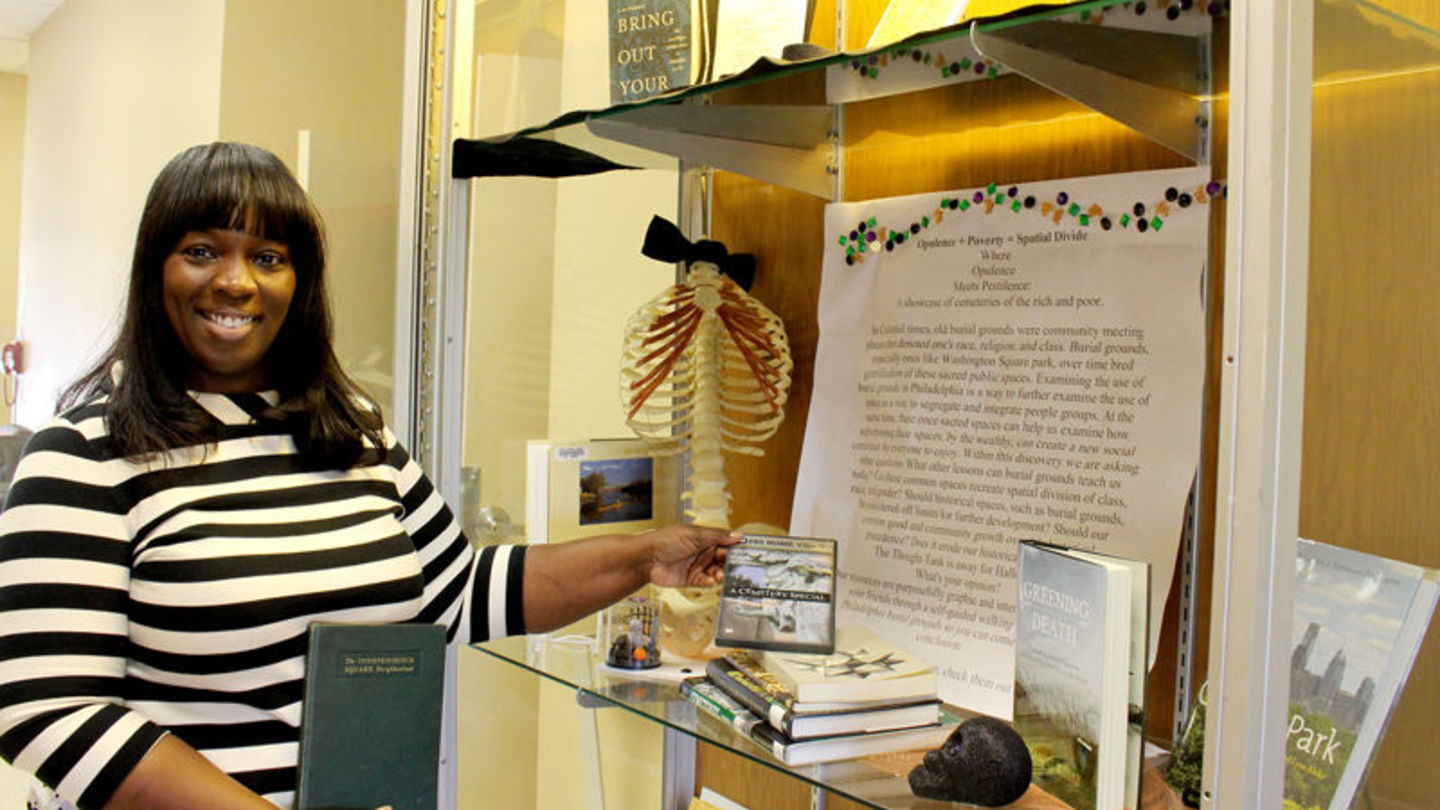
Washington Square in Philadelphia has a history as old as the city itself. One of the five original planned squares devised by William Penn and his surveyor Thomas Holme, today it is part of Independence National Park in the heart of the city's historic district.
Washington Square's tree-lined avenues — an oasis in urban Center City — and its historic sense of place attracted the interest of Temple University Ambler History senior Sherrice Johnson who wanted to explore well beyond the "surface history" of the location, both figuratively and literally.
What today is a beautiful city park — a natural respite for people of all ages to take a moment to catch their breath in the hustle and bustle of city life — is built upon centuries of human tragedy.
"The history of Philadelphia's Washington Square Park is truly fascinating. In the 1700s it was a burial site for the city's African American community. It was a potter's field, a grave site for the poor and indigent," said Johnson, an adult learner who returned to the classroom with the hope of becoming an historian. "It's such an interesting juxtaposition, how people currently engage the location of what was was once essentially a mass grave. It was a burial ground for the poor but today it is an area of such wealth and prosperity."
Using courses such as Engaging Spaces, Race & Poverty in the Americas, Sustainable Environments and Writing American History as inspiration, Johnson has developed a student research exhibition examining the use of burial grounds in Philadelphia, which is currently on display at the Ambler Campus Library.
"We wanted to examine the idea of taking older cemeteries and repurposing them," said Library Assistant Joanne Rempfer, who worked closely with Johnson to develop the exhibit and macabre topic, which goes hand-in-hand with the Halloween season. "We tried very hard for find the earliest maps that we could that showed the locations of the older burial sites.
Rempfer said the exhibit "provides a sense of history that many people likely don't know about."
"This is the first student-curated exhibit that we've had the Ambler Campus Library but we hope it will be the first of many," she said. "Students can come to the Library at any time and propose a topic of interest."
Johnson's exhibit, "Where Opulence Meets Pestilence: A Showcase of Cemeteries of the Rich and Poor," will be on display in the Ambler Campus Library throughout October.
According to Johnson, Washington Square's tragic past continued throughout the 18th and early 19th centuries. During the Revolutionary War, the square served as a burial site for Colonial soldiers. Victims of the city's horrific Yellow Fever epidemics were also interred there in mass graves.
"It was an open burial pit and the stench of death was everywhere. The surrounding community came together and went to local leaders to ask if at least a line of trees could be planted so that it wasn't such an open eye sore — the change to Washington Square started with people who had a desire for a greener, more livable space," she said. "Examining the use of burial grounds in Philadelphia is a way to further examine the use of space as a way to segregate and integrate groups of people. At the same time, these once sacred spaces can help us examine how repurposing these spaces can create a new social construct for everyone to enjoy."
Washington Square has taken on "a whole new life" in the centuries, Johnson said.
"In colonial times, old burial grounds were community meeting places that denoted one's race, religion and class. Burial grounds, especially ones like Washington Square Park, over time bred gentrification of these sacred spaces," she said. "With thousands of dead buried there, it could be considered a forbidden space; a place you didn't want to go to. Today it is a treasure that everyone can enjoy. There is a school a block away that plays football there; a nearby nursery brings infants to play there; they have weddings from Fridays through Sundays. As an historian, I want to celebrate the complex history of spaces like this."
Of course no burial site would be complete without its share of ghost stories and Washington Square is no different. According to local paranormal lore, the square is haunted by a Quaker woman names Leah who patrols the park at night to protect the dead from grave robbers. More than a few ghost tour participants — and at least on Philadelphia police officer — is said to have seen the ghostly apparition making her appointed rounds.
"People have said they have her ghostly sounds at night as well," said Johnson. "I've actually done some recording in the park at night, but I haven't heard anything yet. I'm going to continue recording well into December, so you never know!"
Johnson said one of the goals of the exhibit is to encourage people to ask questions and open dialogues about a variety of topics.
"What other lessons can burial grounds teach us today? Can these common spaces recreate spatial division of class, race and gender?" she said. "Should historical spaces such as burial grounds be considered off limits for further development or should the common good and community growth override historical precedence? Does it erode our historical landscape?"
All of the books used as part of Johnson's exhibit are part of the Ambler Campus Library's collection. Students, faculty and staff are invited to check them out at any time.
The resources that comprise the exhibit are "intended to aid you through a self-guided walking tour of all of the Philadelphia burial grounds so you can come to your own conclusions," Johnson said.
